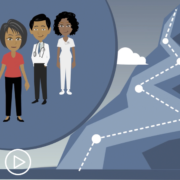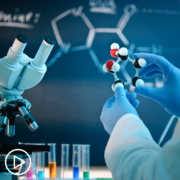AML Treatment Decisions | Understanding Factors That Impact Your Options
AML Treatment Decisions | Understanding Factors That Impact Your Options from Patient Empowerment Network on Vimeo.
An acute myeloid leukemia (AML) diagnosis can be different for each individual patient, so how is a treatment approach determined? AML specialist Dr. Jacqueline Garcia provides an overview of factors taken into consideration when choosing therapy, including age, overall health, and the patient’s preference.
Related Resources:

|

|
Transcript:
Katherine Banwell:
With all the treatment options available, how do you decide who gets what? Tell us what is considered when choosing treatment for a patient.
Dr. Jacqueline Garcia:
When I – this is a complicated question, because it’s not like you follow any particular algorithm. But when I meet a patient, I make a decision on what’s important to the patient and what’s their goal. If I know – I need to understand their overall health to get a sense of are there ongoing competing risk factors that are active and more likely to impede with response, ability to deliver chemo, ability to get to transplant, something that tells me that’s not a possibility, or is their age too advanced – meaning greater than 75 – where we know that some of the treatments are not safe to deliver in that setting?
So, I take a look at a patient’s overall health and age to make a decision. I take a look at bone marrow biopsy and lab findings to understand the flavor of their leukemia, from chromosomes to mutations. And because I am familiar with the data to give me a sense of what’s safe, what’s tolerable, and importantly what types of diseases, or subtypes of AML, would respond to one therapy over another, that’s how I formulate a recommendation.
And based on all of that, all together, I’ll talk to them about treating the AML in steps. The first step is getting them into a remission, which can be done regardless of therapy type. That means to get their bone marrow under control, blood counts to recover. The second step, which is a more involved conversation that I often give a little bit of a hint of, but I go into greater detail over time, because we will see each other quite a lot, whether in the hospital or in clinic, is how to keep them in remission.
And that’s where details about things like transplant come into play. I do my best to not overwhelm them, because when a patient hears the word transplant – and that’s often what they hear from family and friends because that’s what you can Google – they don’t know that there are many things, or many weeks of therapy, that have to happen in advance of transplant even being considered or happening. And transplant can’t even happen until someone’s in remission.
But that is always on the forefront of a leukemia doctor’s mind, “Can I bring this patient to a transplantation? How successful will I be and what else do I need to give them to get them there sooner, safer, with a deeper response?” So, that way transplant could be successful. Transplant, by the way, is when we give a patient someone else’s stem cells that match their HLA typing, or their white blood cell signature.
And it helps us to use someone else’s immune system to completely irradicate any microscopic leftover leukemia in a patient. But that is only successful when patients have good disease control or remissions. And that is only also successful if we have a donor for the patient, both of which require at least several weeks to a couple of months of therapy. But that process is always initiated and ongoing in the background. And so, we often do this in piecemeal, because getting a diagnosis is already overwhelming. Learning about treatment is overwhelming.
Learning about the frequency of labs, transfusions, being hospitalized, and then details about what a transplant would entail can be also overwhelming. But a lot of family and friends like to ask, because they feel like that is one way they might be able to help a patient. So, I know that they often eagerly ask the patient, “Well, what about this? How can I help?”
Katherine Banwell:
Right. I can imagine that patient preference is also considered. But what kind of questions should patients ask about their treatment regimen?
Dr. Jacqueline Garcia:
I always tell patients that I care very much about things like travel, hotels, all that jazz. But I always tell them let’s first talk about their health, what treatment I would recommend based on the available options and what their disease would mostly respond to, because I want it to be successful. And I always tell them let’s reserve questions on how it’s going to be done for last. I call that the logistics. I will never bring up or recommend something that could never be possible. But that being said, I try not to let the commute determine the decision.
Whether or not there needs to be a hospitalization versus a hotel stay. I always consider then the background, but that financial decision should not drive the best treatment choice for a patient. Very fortunately, we’re in a country where patients have the ability – often, not always – to seek second opinions or to travel to academic centers.
And because AML is an emergent or life-threatening disease, many insurance providers allow patients to come up to a big center to be treated, which I think is more than appropriate. So, we get into details of logistics last, because that’s the one thing that we can often overcome by providing additional resources and support. In terms of patient preference, if that’s what you mean with that, I would say I leave logistics to last, but we always consider and we do our best to accommodate.
And that might be where we inform them we will look into getting a local partner to help us with additional therapies after the first month or upon discharge. So, it totally depends on the scenario for a patient, whether or not they have a local provider and a local hospital that could accommodate acute leukemia. I always tell patients ideally you don’t want to go to a place that only sees this once per year. You want to go to a place where everyone has seen it multiple times, including the nurses on the floors.
So, that way, when there’s a complication, everyone knows what to do. We don’t want any “surprises” when it’s really just run-of-the-mill standard stuff for us every day. In terms of what patients desire, we always keep that in the conversation of their level of support. Can they swallow pills? Are they able to cope with being in and out of the hospital? All that stuff gets considered, but I think if they hear about the plan, about what’s required, when my expectation would be for a response, when the frequency of trips to a big city would decrease, how I could get a local partner to help with some of the lab or transfusion burden.
Many of those preferences that they thought they had diminished, because they recognize that we found a way to make it work.
Katherine Banwell:
Dr. Garcia, you mentioned earlier the fact that some therapies can cause a lot of side effects, like nausea. And certainly, speaking up and telling your healthcare team how you’re feeling and what some of the symptoms and side effects are, that’s really essential. What is the impetus for someone to consider changing treatment if something is just absolutely not agreeing with them?
Dr. Jacqueline Garcia:
So, there are many reasons to change a treatment. One is a patient doesn’t tolerate it. It depends on what the issue is. Is it something that’s serious, like a liver or enzyme abnormality that is very abnormal, or a new cardiac problem where it would warrant a change or a dose reduction? That makes sense. There is definitely – often, there’s a lot of guidance in the package inserts or within a clinical trial and how to manage that. But if patient has some intolerabilities that could be overcome with standard supportive care methods, I would make sure we’ve done that.
So, I would make sure you give you medical team the chance to fix any nausea. We have so many great antinausea drugs. I would want to make sure – or if constipation or diarrhea. It’s often a GI issue that patients get really bothered by.
I would try to delineate whether or not the side effect was really from the chemo or is from the leukemia that is not yet under control. Or is it another medical condition or a drug-drug interaction that was missed. So, I would do my best to make sure there wasn’t something that was fixable or something else that should be addressed. We otherwise would recommend changing therapy for an extreme intolerability if there was another equivalent better option. And if someone’s disease does not respond to treatment, then we would consider another therapy, too.







